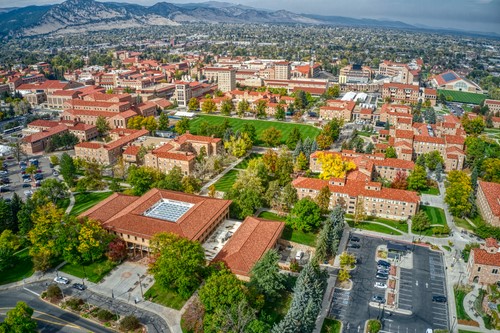Exploring the Colorado Floodplain Map Helps Mitigate Risks

When you’re living in a state featuring the highest overall sea level in the U.S., flooding may feel like a distant threat. But Coloradoans should know that the threat is widespread and real. This is why it’s important to understand the Colorado floodplain map.
Of all the natural disasters, floods continue to be some of the costliest natural disasters anyone can endure. Furthermore, dealing with flood damage takes multiple forms of protection in order to stay properly protected.
Drivers will need the right form of auto insurance in Colorado because the damage even a flash flood can produce enough damage at a rapid pace to destroy your vehicle completely. The result? A financial disaster.
If you’re renting or a homeowner, coverage is available to protect your place of living and personal property from many different perils thanks to rental insurance and homeowners insurance. But neither of these policies offers protection from flood damage.
Therefore, having flood insurance in Colorado is important, and knowing where you stand in terms of risk is a great tool to help you prepare for the worst. Learn more about the Colorado flood map, the risks Coloradans face, and how to protect yourself for less against such perils.
Colorado Floodplain Map by Address
The risk of flooding is a bit different in The Centennial State but one thing remains, even within each city, region, or neighborhood, risks can vary greatly by address. There are many reasons for this, but either way, having a Colorado floodplain map that can search by address is critical.
The 2013 Colorado flood disaster changed how the state looked at flooding leading to the creation of the 2015 legislation passing the bill for the Colorado Hazard Mapping Program. Now, residents of Colorado, government officials, and those conducting projects can view the impact in today’s world as well as the future.
Fortunately, CHAMP (Colorado Hazard Mapping Program) delivers for residents looking to view things on a personal level. The invaluable portal from the Colorado Water Conservation Board provides a variety of features, including:
- The ability to view flood zones and risks on an address level through its interactive map.
- The map also has many other features that provide the ability to look up data and interact with particular filters.
- Documentation about projects that may affect flooding throughout the state.
- Records of public meetings.
- A community calendar to stay up to date on upcoming events involving issues related to public projects and related topics.
A tool this powerful can help residents make informed decisions, but it’s also important to keep things in perspective. Flood damage accounts for some of the costliest claims in the insurance industry. Considering 1 in 4 claims that relate to floods come from homes outside of high-risk zones, the coverage is clearly important for everyone to consider.
Where Does It Flood in Colorado?
When looking at floodplain maps in Colorado, it becomes clear that even if some areas are more prone to flooding, the threat is relevant throughout the state, but for different reasons. There are several factors that contribute to flooding and they are important to remember not only for today but for the future as well:
Weather Patterns Are Changing
Floods keep affecting Colorado in different ways. It’s a different type of threat than one might see near the coast of California or where hurricanes are present, but nevertheless, the threat continues to prove itself.
Sadly, another weather event continues to have a large impact on the state, wildfires. The extreme drought that the West is experiencing is set to only continue over many years and while it may feel like less rain and drier conditions work against flooding, that’s only looking at the surface level.
The problem is deeper than that, or rather, the fact that roots aren’t deeper as a result. Because the vegetation is being destroyed, there isn’t anything to absorb the runoff when it does rain or snow. This causes a major problem and leads to more flooding as the rainwater has to find somewhere to go.
Complicating things further, the way it rains in the state continues to evolve. These days, the trend isn’t that there is no precipitation during wetter months, but these months aren’t getting the same amount of rainfall and snow. Fall months show trends of an increase with spring months decreasing the amount of rainfall the state is experiencing.
Population and Infrastructure Change
The population trends of Colorado seem to paint a much different picture than they did a few years ago. What was once a state facing migration from others, is now seeing the influx of transplants slow down.
An increase in population will typically lend itself to higher flood risks. But just because the state is gaining fewer incoming people, doesn’t mean that the risks haven’t been and aren’t still increasing due to ongoing projects.
When a state gets more people, it has to build to accommodate them. On a government level, this occurs, but it’s also the natural order of commerce. Entertainment and social hubs are created to generate amenities, more stores come into town, larger roads are needed, and anything else that supports modern American life.
It doesn’t have to be complicated either. Simply creating neighborhoods, condos, and other types of homes is enough to do it. Because these projects all have something in common with the problem of wildfires: they take away vegetation.
The concrete that is necessary to create such structures creates less plant life to absorb the water and as a result, the runoff has to find a place to go. Many times, this means it finds your home or property and destroys it.
Cities in The Front Range Prone to Flooding
The Front Range Urban Corridor is where most of Colorado’s population lives. Here, you’ll find 5 million Coloradans residing here in metropolitan areas, urban centers, and college towns. It should come as no surprise that such areas are at higher risk of flooding as well. While all homes have the risk of suffering a loss from a flood, here are the top 10 cities at risk in The Centennial State:
- Aurora
- Boulder
- Centennial
- Colorado Springs
- Denver
- Fort Collins
- Greeley
- Lakewood
- Pueblo
- Thornton
These cities are among some of the most populous in Colorado and continue to be urban hubs for population development. When you consider the factors mentioned above and the growing threat of wildfires for many of these cities, the trend of an increased flooding threat continues to be a peril residents must keep in mind.
Tips for Reading a Colorado Floodplain Map
When it comes to reading FEMA flood maps, there are some tips and tricks you may find helpful, especially if you’re new to reading them. If you’re new to reading a Colorado flood zone map, it can feel a bit daunting. Thankfully, it doesn’t have to be such a challenge with these great tips:
FEMA Flood Map Color Codes
It’s important to note that there are 18 flood zones shown on a FEMA flood map. These zones each have a category and corresponding color, high-risk, low-to-moderate risk, and undetermined risk.
If an image is in a high-risk flood zone, there is a blue shade. Moderate-risk areas receive orange shading. Finally, low-risk areas are either clear or unshaded. Here’s how they all breakdown:
High-Risk:
- Flood zone A
- Flood zone AO
- Flood zone AH
- Flood zones A1-A30
- Flood zone AE
- Flood zone A99
- Flood zone AR
- Flood zone AR/AE
- Flood zone AR/AO.
- Flood zone AR/A1-A3
- Flood zone AR/A
- Flood zone V
- Flood zone VE
- Flood zones V1-V30
Low-to-Moderate Risk:
- Flood zone B
- Flood zone C
- Flood zone X
Undetermined Risk:
- Flood zone D
*Note: Having an undetermined risk (flood zone D) doesn’t mean there is no risk of flooding. This is telling you that the section has yet to be mapped, meaning the actual threat level is unknown. It is always advised to maintain flood insurance and any other necessary coverages to protect from flood damage regardless of the flood zone you live in.
Use Landmarks
You’ll notice that a Colorado floodplain map from FEMA is going to have landmarks, and this is great news. It can get confusing quickly if you’re simply looking at a grid but when you have landmarks you can use in relation to the map’s scale, you’ll be able to more accurately locate where you are and read your map.
Your Legend Is Also a Great Reference
Your FEMA flood map’s legend provides you with the map’s scale, water boundaries, and the flood zones you’ll be looking at. It’s an important tool for successfully navigating and reading your flood map.
Understanding Flood Zone X in CO
Flood zone X (flood zone X500) is the best flood zone a homeowner can find. What this means is that the properties within this zone are located outside the 500-year floodplain and receive protection from a 100-year floodplain via a dam or levee.
While this doesn’t mean you’ll never have the threat of flood damage, it does mean that your chances of experiencing flooding are lower than others within your state. Again, 500-year floodplains and all floodplains use probability but it’s always possible for a flood to occur.
Flood Zone AE in Colorado
Floodplain maps in Colorado depicting flood zone AE are showing high-risk flood zones. Properties located in these zones are going to face much larger threats in terms of flood damage than other regions of the state. It also means expecting to pay more for coverage, including auto insurance, as a result.
Colorado Floodplain Map and Additional Resources to Help You

For homeowners, maintaining the right level of home insurance is important, but when it comes to a flood claim, they will find that it won’t be enough. This is why we here at Freedom Insurance Group recommend maintaining a flood insurance policy as well.
The coverage is also beneficial for renters because protecting the structure of your home is the responsibility of your landlord, suffering flood damage without a flood insurance policy means you’ll have to pay for restoring your personal belongings on your own.
Furthermore, while everyone needs to maintain proper auto insurance policies, without having comprehensive coverage, flood damage won’t be covered. A comprehensive car insurance policy helps protect your vehicle against potential damage from weather-related incidents, including flooding.
Regardless of where you live, having the right coverage is imperative, and we can help. Rather than just looking through standard, government-issued coverage, our agents work with many top-rated flood insurance companies to help deliver you a variety of options.
These options are important because they allow you to compare rates among different carriers and choose the cheapest rate without cutting coverage. Each brand will look at your risk factors but they will all do so differently, leading to different rates. Failing to compare your options likely means overpaying.
Avoid this issue and get the coverages you deserve for less no matter where you fall on the Colorado floodplain map. Contact us today and enjoy a free, no-obligation flood insurance quote, home insurance quote, or auto insurance quote designed to help you stay covered for less.






